Türkiye (Turkey)
Türkiye (Turkey)
-
-
-
-
-
-
Post #31 - January 27th, 2011, 2:10 pmThat concludes my trip to Turkey. It was a wonderful trip where I got to visit family, learn a lot about the culture, and sample so many different aspects of the cuisine. I really enjoyed writing about my experiences and remembering all the great food I ate. Afiyet olsun!
-
-
Post #32 - January 27th, 2011, 2:55 pm
I may be almost as sad as you that your trip is at an end, I really enjoyed this series of post.turkob wrote:That concludes my trip to Turkey.
-
-
Post #33 - January 28th, 2011, 7:05 amG Wiv wrote:
I may be almost as sad as you that your trip is at an end, I really enjoyed this series of post.turkob wrote:That concludes my trip to Turkey.
I couldn't agree more!
Thank you so much for the time, thought and effort you obviously put into these magnificent posts, turkob!
-
-
Post #34 - July 26th, 2014, 4:33 pmHi,
FoodFirst, who translated the first Chicago Thai secret menu, is writing a Turkish cookbook. Via her blog EatingAsia, she has written an article encouraging people to road trip through Turkey. Road Tripping in Turkey, or How to Self-Drive and Survive originally written in 2013 has been updated.
Regards,Cathy2
"You'll be remembered long after you're dead if you make good gravy, mashed potatoes and biscuits." -- Nathalie Dupree
Facebook, Twitter, Greater Midwest Foodways, Road Food 2012: Podcast
-
-
Post #35 - August 21st, 2015, 11:56 amJust returned from another great visit to Izmir. It's a wonderful coastal town with lots of energy. I enthusiastically recommend it to anyone visiting the region in lieu of the more touristy Kusadasi.
I was a little surprised by how many of the same restaurants I ended up at but I think this was due to a combination of these remaining my family's favorite joints and my desire to seek out places serving up classic Turkish style food. I will say that my limited experiences with non-Turkish foods were not very good.
Izmir is first and foremost a seafood town. There are dozens of seafood places serving up the day's catch up and down the waterfront and in taverns called meyhanes that line the alleys of the Alsancak neighborhood. I don't have much to add to my previous write up about how a meal is served at a classic raki, meze, balik restaurant but I'll summarize.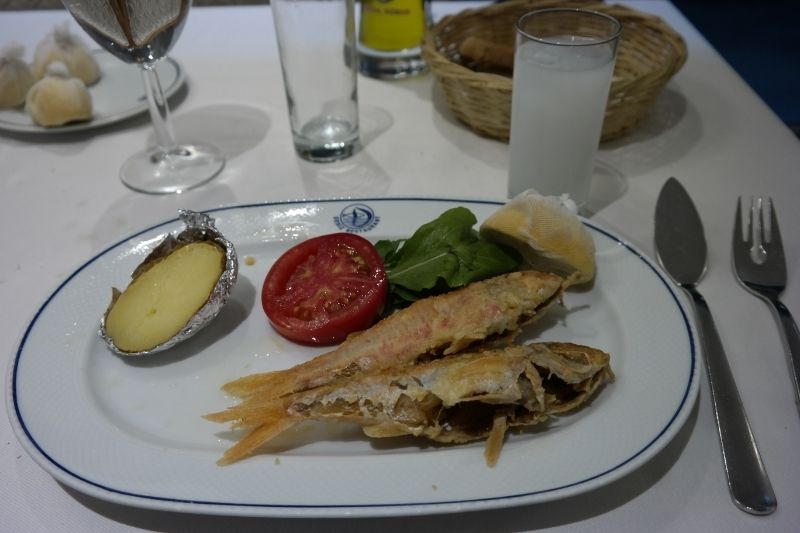
The meal begins with a selection of cold meze that you select from a tray or display case up front. Afterward you have the option of a warm appetizer round that they call orta sicak which is typically fried calamari, grilled octopus, or fried eggplant. For a main you select fish from the counter and ask them to prepare it. A personal favorite are fried mullets. The whole event pairs beautifully with a bottle of anise-flavored liquor, raki.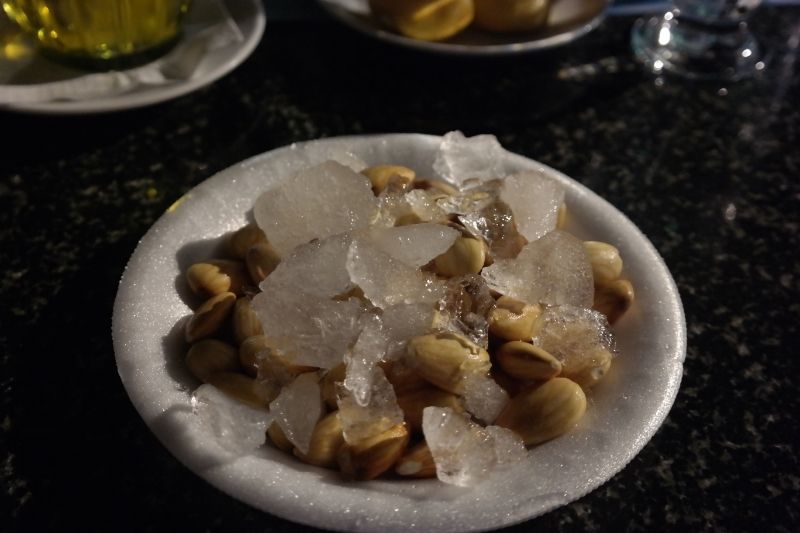
Almost as common as the raki that shows up on every table are the buzlu badem, iced almonds, that are sold from street carts that pass by. Fish is almost exclusively eaten outdoors on a patio (the restaurants have limited indoor seating) so there are a number of street vendors that walk by. It's interesting that the restaurants allow food to be sold from street carts that is intended to be eaten at the restaurant. The iced almonds are fresh so they are kind of chewy. They make for a nice snack between courses.
I visited Antepli Ramazan Usta on my last trip to Izmir and though it has changed locations, the food remains top notch. There are many similarities between the way a meal is served at a fish restaurant and a kebab restaurant. Note that while most restaurants do offer a menu, I realized more and more than you're expected to order without consulting a menu (of course knowing Turkish helps immensely). Many items are not served on a particular day and most people order the same 4-5 things at any given place. The primary decisions are made at the front of the restaurant before you even sit down.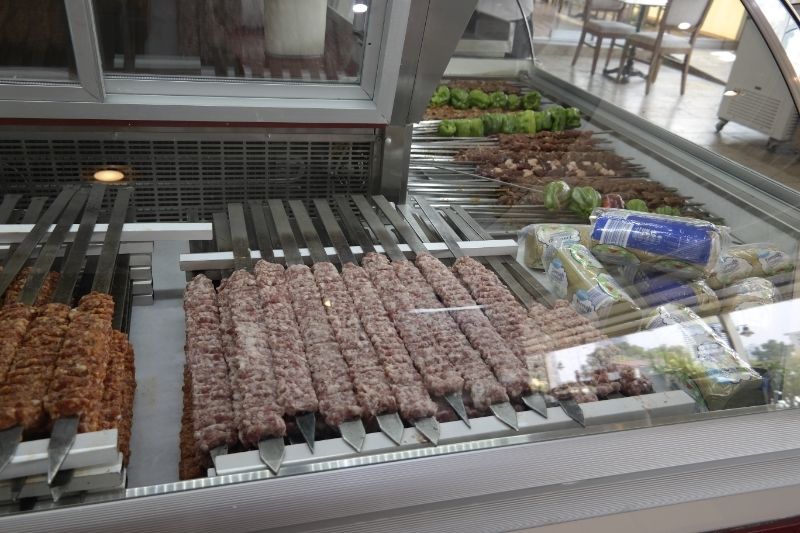
Much like at a fish restaurant, a trip to a kebab restaurants begins at a display case up front. The day's kebabs are on display and you can see them cooking the kebabs over coals in the back. You don't see mezes laid out in the case like you do at a fish restaurant, instead most places offer a mixed salad and a couple vegetable spreads to start things off (often gratis unless you want more). At Antepli Ramazan Usta the meal begins with a small plate of rocket and herbs and small orders of eggplant mashed with yogurt and a spread called ezme which is made up of red pepper paste, tomatoes, walnuts, and pomegranate molasses.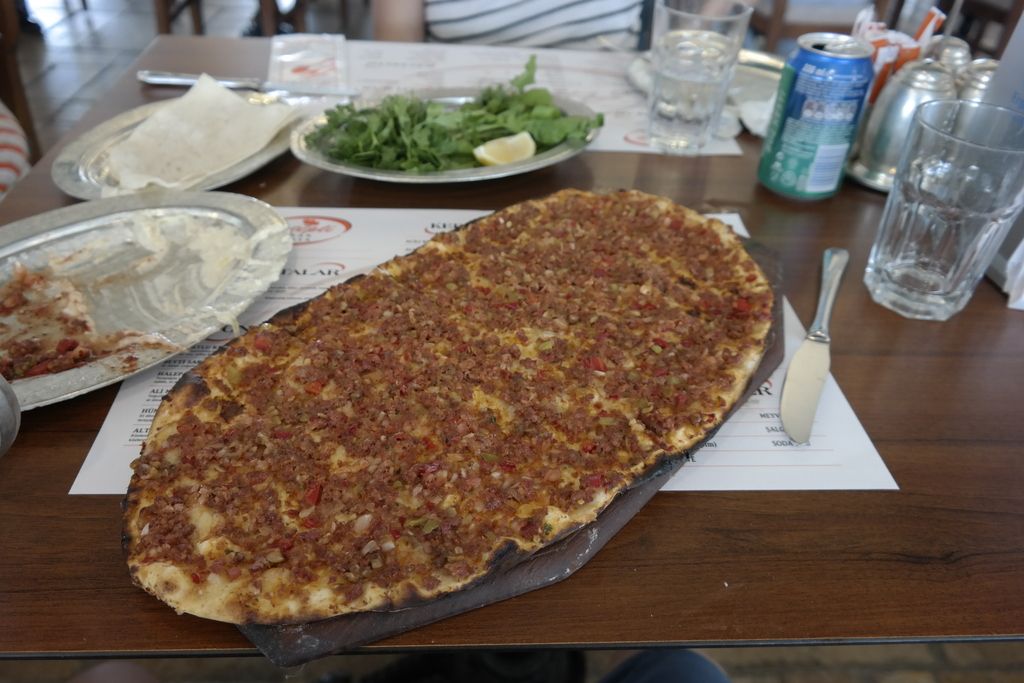
Next up is a lahmacun that plays the same role as the orta sicak at a fish restaurant though more substantial since there are fewer cold appetizers. A good lahmacun should have a light crispy bread as a base that is still pliable enough to roll up like a burrito and well seasoned bits of ground lamb, onions, and tomatoes on top. Antepli Ramazan Usta's lahmacuns come in three sizes, findik (hazelnut) is the smallest, ceviz (walnut) is a medium, and the regular size is the large, pictured above. You can also order a pide in place of a lahmacun, which is similar but with a thicker crust and the filling often includes cheese or eggs.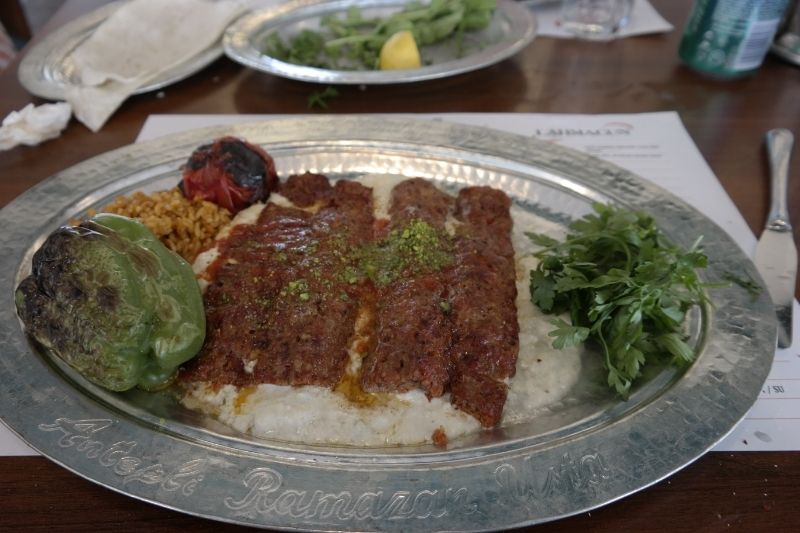
The main attraction is the meat which is almost always cooked over coals. We saw a number of large shops dedicated to selling charcoal, though admittedly there is a growing trend of using gas. Much like at a fish restaurant, you first order the type of meat you want, then you specify how you would like it prepared. Some options are served over yogurt, served with grilled tomatoes, served wrapped in lavash, or my personal favorite, served over mashed eggplant. The eggplant prep is famous enough that it has a special name, Ali Nazik. Pictured above is an adana kebab, which is a spicy ground lamb kebab, served Ali Nazik style. Much like raki is on every table at a fish restaurant, at a kebab restaurant you'll see metal cups dedicated to serving ayran, a beverage made with yogurt, salt, and water. Once upon a time every restaurant made their own, but these days there are many commercially available options, which are good. Antepli Ramazan Usta makes their own ayran, and it's delicious.
I made it to a cag kebab specialist called Ali Usta Oltu Kebap which is representative of the growing trend of eastern Turkish cuisine popping up in western Turkish cities. Cag kebap is similar to a doner kebap except it is rotated horizontally over a wood fire instead of vertically over coals. This particular restaurant calls it Oltu kebap which is in reference to the eastern Turkish city of Oltu.
This kebap specialist does one thing but it does it extremely well. The thinly sliced pieces of lamb, which they call yaprak (leaf), are roasted until the edges are nice and crispy. Typically cag kebap is sliced directly from a rotating spit, but this place goes the extra mile to ensure each piece is well charred by slicing the meat raw and cooking it on skewers.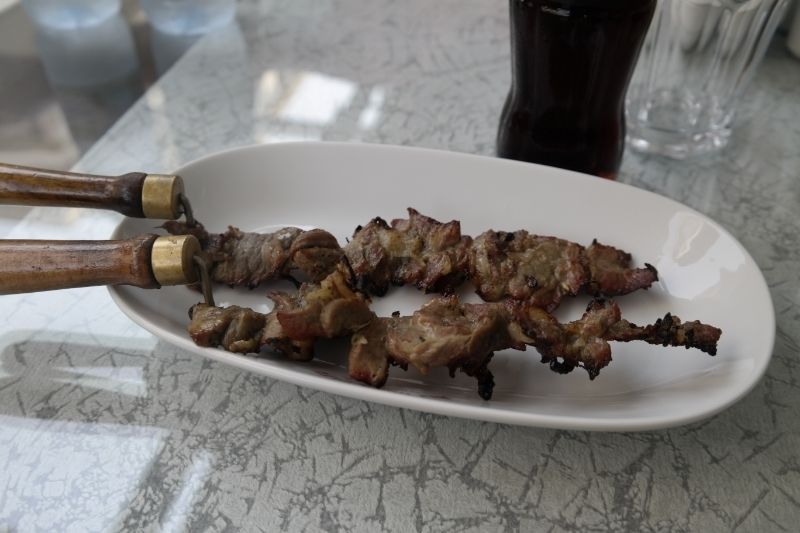
Every five minutes or so a waitress walks around the restaurant with a plate piled high with skewers. Customers order as it goes by, similar to dimsum. The meat it served with durum (lavash), onions, rocket, and a condiment tray of cumin, oregano, and aleppo pepper.
-
-
Post #36 - August 21st, 2015, 11:13 pmMay "borrow" a few ideas. Thanks."In pursuit of joys untasted"
from Giuseppe Verdi's La Traviata

